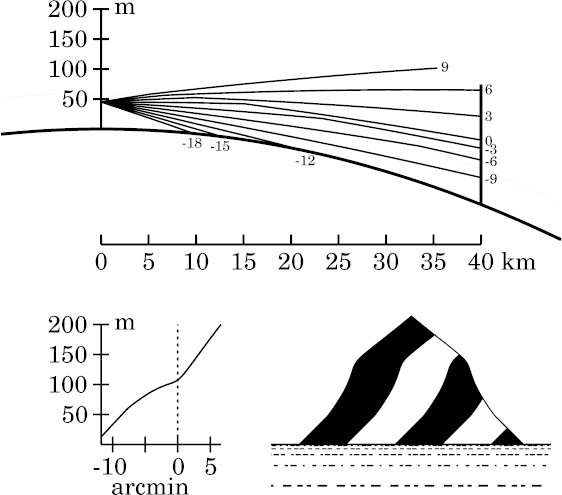
However, Wegener did not use his periodicity effect to explain the effects of varying eye height in superior mirages. Because height of the observer strongly modifies all mirage phenomena, and because Wegener's periodicity principle can be used to explain some eye-height effects, even in realistic model atmospheres, it's worth showing some examples here.
The basic idea is that the discrepancy in periodicity of ducted rays between the edges of Wegener's blank strip and its center (the astronomical horizon) causes the edge or “limiting” rays to fall out of step with those near the (astronomical) horizon, with successive reflections of the rays at Wegener's density discontinuity. So the images of miraged objects become increasingly distorted with distance.
However, as this discrepancy also increases with height above the bottom of the duct, it's apparent that the image distortions in Wegener's model must increase with height of the eye, as well as with distance.
This page illustrates this effect, using the usual 2° temperature discontinuity in Wegener's model to produce the duct, and the 200-m high target I've used for other superior-mirage simulations. The discontinuity is at 60 m height, and the bottom of the duct is just above 45.3 m. I'll start out with a relatively nearby object, 20 km away, and then repeat the exercise for a more distant target, at 40 km. At each target distance, I'll start just below the bottom of the duct and progress upward; the initially simple images gradually become more complex.
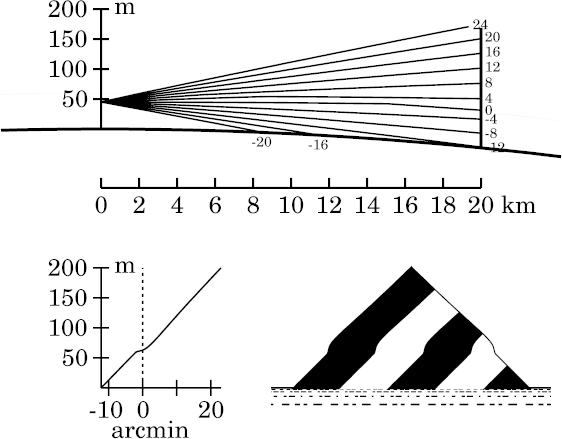
The distorted zone, of course, lies just at the astronomical horizon,
where the line of sight meets Wegener's discontinuity most obliquely.
(Notice the kink in the astronomical-horizon ray about 15 km from
the observer, where it is refracted at the discontinuity.)
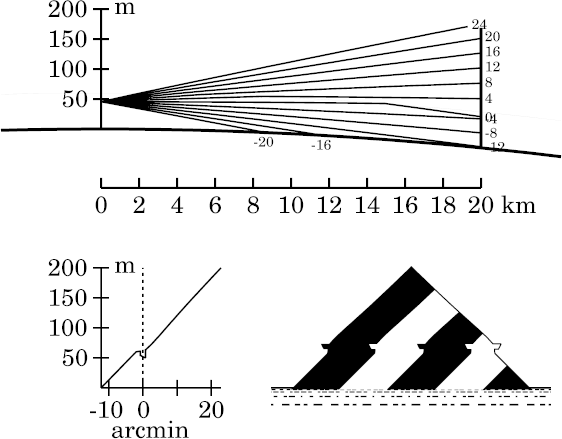
Notice that the astronomical-horizon ray is now much more strongly deviated than in the previous case, because it is now reflected rather than refracted. It meets the target nearly in the same place as the direct ray 4′ below the astronomical horizon; so the miraged strip of target comes from well below the neighboring erect parts of the image — which accounts for the “ears” on the simulated image. (The slope of the ends of these projections shows that they form an inverted image.)
Caution: The sudden appearance of a sharply delimited miraged strip on
entering the duct here results from the unrealistic discontinuity in
Wegener's model. Real mirages don't act this way.
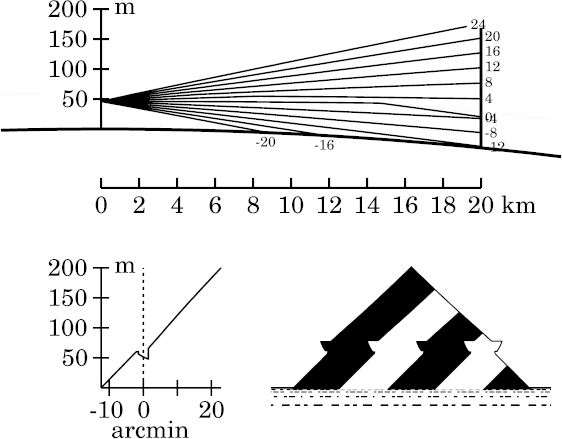
The image inversion in the miraged strip is now more obvious than in the
previous example. This is a simple superior mirage of the 2-image type:
there are only two images of the miraged zone: the inverted one in the
strip, and the erect image of the same features below it. Because the
inverted image lies above an erect one, this is a classical
superior mirage. (Unfortunately, it's also an unrealistic effect of
Wegener's unphysical density discontinuity.)

Notice that Wegener's
distortion
effect
is beginning to appear here: the sides of the inverted image are now
appreciably curved.

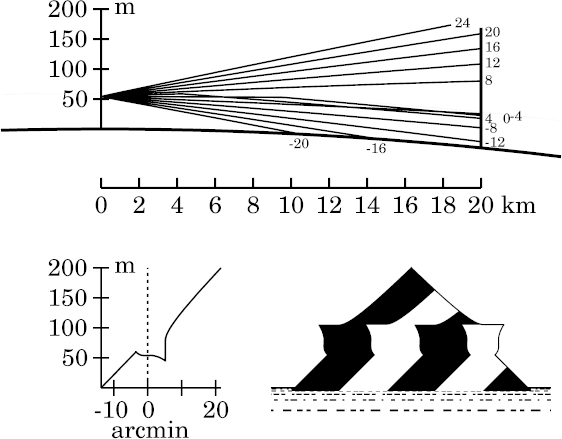
However, there are still only two images of the miraged zone: an inverted
(though distorted) one above an erect one. So this would still be
interpreted as a simple, 2-image, superior mirage.

From an optical point of view, the increased
foreshortening of the curved reflecting surface (i.e., Wegener's density
discontinuity) has shortened its effective focal length, especially
near the astronomical horizon. The zonal
aberrations of this foreshortened cylindrical mirror would be regarded
as the cause of the shorter focal length near the horizon.

Because of the multiple images and vertical symmetry, this would certainly
be regarded as a Fata Morgana display, if it could appear in the real
world. Actually, this is just an artifact of Wegener's oversimplified
model.
The increased distance also hides some of the target below the horizon, and makes the miraging strip at the astronomical horizon appear to fall higher up on the target itself. However, the inversion at 60 m height still strikes the target in the same place; so the miraged region contains images of the same part of the target as before.

There's also looming: the middle of the target is raised well above its geometric position by the refraction at Wegener's density discontinuity. And the looming is largest right at the astronomical horizon, where the observer's line of sight meets the discontinuity most obliquely; look at the kink in the astronomical-horizon ray. But that intersection of the horizon ray with Wegener's density discontinuity occurs only about 15 km from the observer (see the ray diagram for the target at 20 km for a closer view of it).
Below the astronomical horizon, the looming rapidly diminishes, both because the angle of incidence at the refracting discontinuity is decreasing, and also because the refraction takes place much closer to the target. (Notice that the refractive kink in the ray at −3′ is about 23 km from the observer, rather than the 15 km for the astronomical-horizon ray.) As the refraction occurs closer to the target, there's less path available to displace the ray's intersection at the target. So the looming quickly falls to zero as we look farther below the astronomical horizon.
Above the astronomical horizon, refraction at the discontinuity always occurs relatively close to the observer; so the lever-arm effect of varying distance between the kink in the ray and the target is small. The main effect is a decrease in the refractive displacements because the angle of incidence decreases away from the astronomical horizon. This produces a steady decrease in looming with increasing altitude: a vertical compression , or stooping, of the upper part of the image (notice that the apex of the target has become obtuse, instead of a right angle).
The transfer curve shows that the bottom 30% of the target, which lies
entirely below the refracting discontinuity, is essentially undistorted.
The next 20% is the part below the astronomical horizon, which shows
increasing looming (and therefore, towering) with increasing altitude.
The top half of the target is stooped, because the looming is steadily
decreasing with altitude above the astronomical horizon.

The miraging strip is now much more pronounced than when the target was 20 km from the observer, because the reflected rays near the horizon have had another 20 km to be deviated, and so strike the target much closer to the ground. Both upper and lower edges of the strip are quite marked here.
But the sloping ends of the miraged image show that it's erect rather than inverted. How can that be?
You can't see it here, because too few rays are shown; but in fact, this is one of those re-inverted inverted images on the far side of a ray-crossing — as described by Wegener. (The ray-crossing that produces the second inversion will become apparent when the miraging strip is wide enough to contain more ducted rays.)
Although this erect image nicely illustrates a feature of Wegener's toy
model, it's an unrealistic consequence of Wegener's oversimplified assumption
of a discontinuity. If the thermal inversion is represented by a
continuous
change in temperature, this feature does not occur.
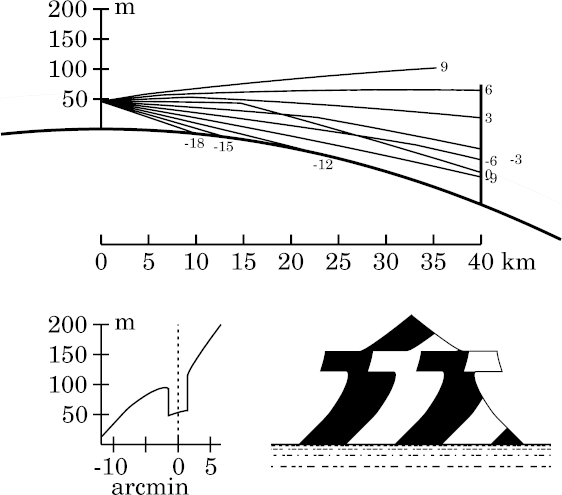
Notice how steep the nearly vertical edges are in the miraged strip. As these are images of target features with a 45° slope, the whole strip is strongly affected by towering (vertical stretching), as well as looming (unusual height above the apparent horizon).
The looming/towering/stooping of details just outside the miraging strip are practically the same as they were for an observer below the duct.
Apart from the Nachspiegelung, which is too small to attract attention, this would appear to be a 2-image mirage, with both images erect.
Warning: A
more realistic
atmospheric model produces a considerably different appearance. Wegener's toy
model should not be taken at face value.
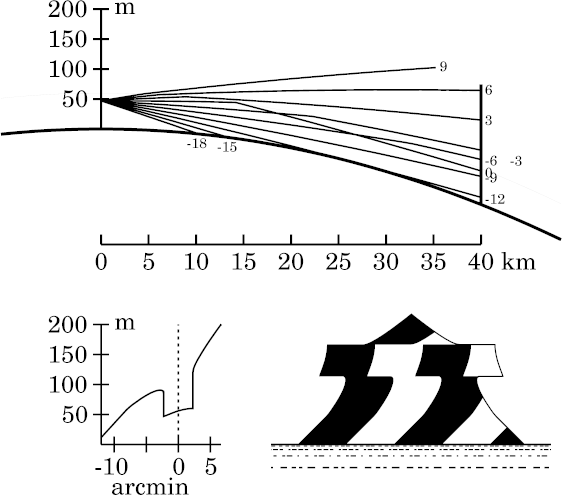
Also, the distortion of the superior mirage in the strip is becoming obvious (notice the curved sides). Once again, this is a result of Wegener's periodicity effect.
Even at this height, the naked eye would probably not notice the
Nachspiegelung,
and a two-image mirage would be reported. However, this would appear
anomalous, as both naked-eye images would be erect.
But, once again, a
more realistic
model behaves differently.
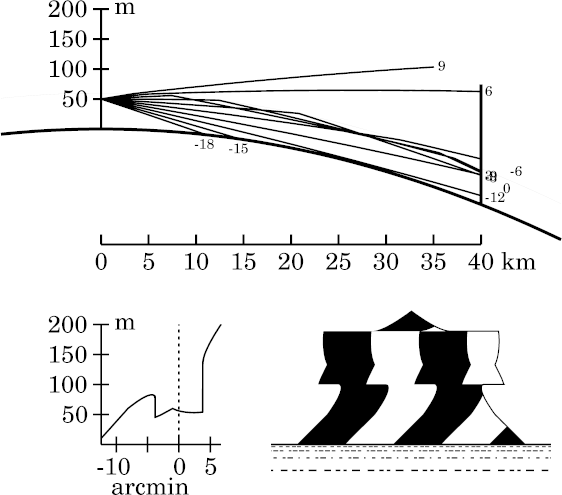
However, we now have an inverted and highly stretched (towering) image near and above the astronomical horizon. That's evidently due to a second reflection of rays near the astronomical horizon, about 36 km from the observer.
The Nachspiegelung is more obvious than before, and the miraged strip centered on the astronomical horizon is now so wide that it hides most of the distortions that were evident to an observer below the duct.
We have a complex mirage display here that is almost a Fata Morgana, with
highly distorted, multiple images. Three images of target features near
50 m height are evident.
In contrast, the
zigzag model
presents a still more complex picture.

The width of the miraged strip is just over 10′ here. This would be
a fairly spectacular mirage to the naked eye, despite the small
temperature jump (2°) that replaces the inversion in Wegener's model.

The strip is now more than 12′ wide, and conceals much of the “direct” image. Five of the traced rays (+6′, +3′, 0′, −3′, and −6′) are ducted. Their many reflections at Wegener's density discontinuity practically outline it.
Features near eye level are multiply imaged; one easily finds 5 or 6
images of some points (draw a horizontal line across the transfer curve,
or a vertical line through the simulated image, to match them up).
This would probably be considered a Fata Morgana display.
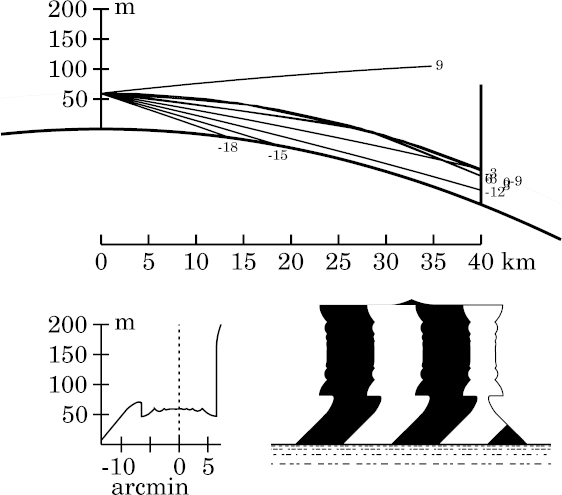
Copyright © 2008 – 2009, 2012, 2025 Andrew T. Young
or the
introduction to mirage simulations
or the
main mirage page
or the
GF home page
or the website overview page